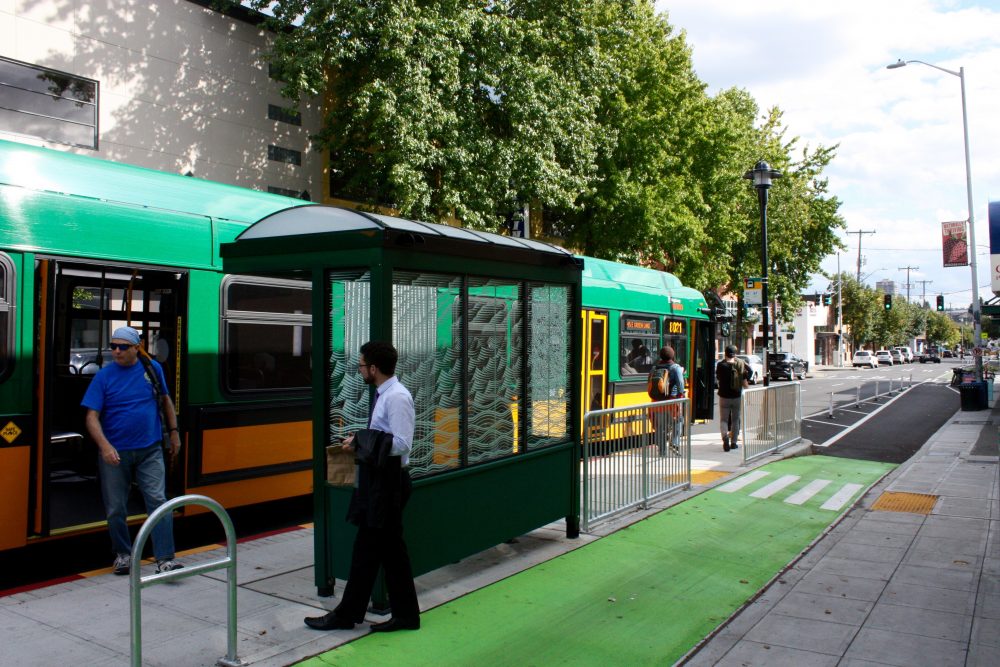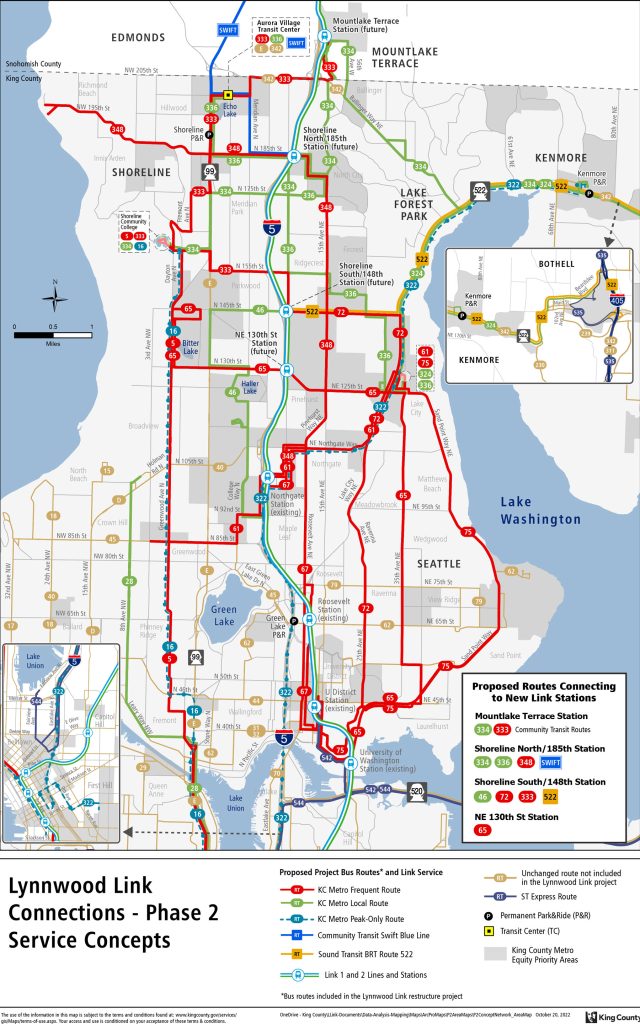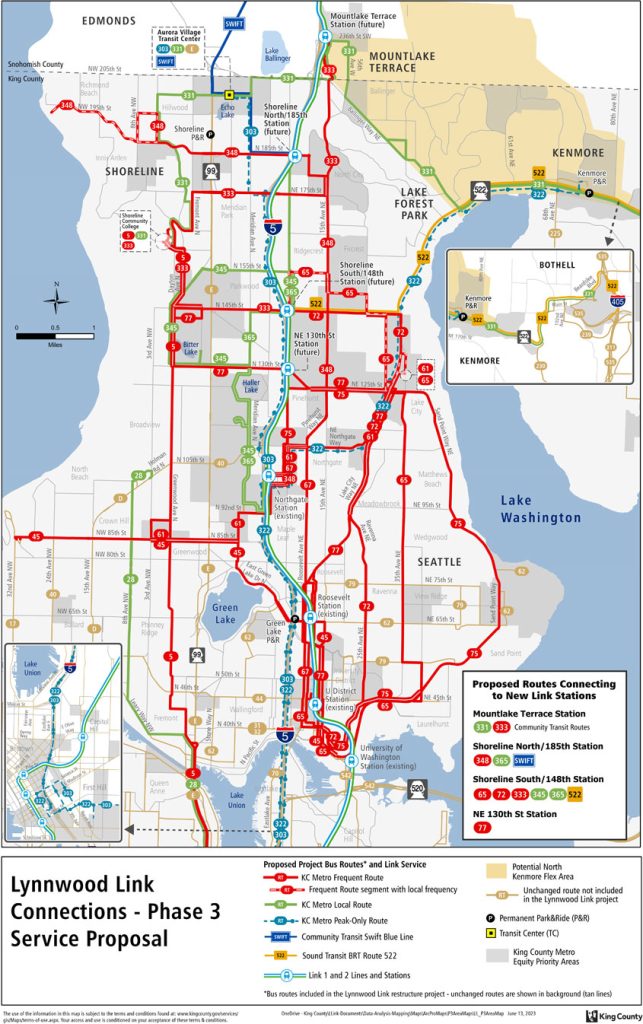
Riders have until August 27 to give feedback on the Phase 3 restructure proposal.
Lynnwood Link is set to open in fall 2024 and bring light rail to four new stations. That alone will be transformative to the regional transit network, but the accompanying bus restructure, intended to better serve the new stations, will also have far-reaching effects. Releasing its Phase 3 proposal in July, King County Metro stressed that the restructure will increase all-day service and improve east-west connections.
Metro has been working on its restructure proposal since 2021, releasing Phase 1 in 2022 and Phase 2 in January 2023, as Stephen Fesler broke down in an explainer in The Urbanist. Fesler noted limited service hours due to King County Metro’s bus driver shortage had handcuffed what the agency could do in terms of expanding the frequent bus network and adding new routes.
That’s still true in Phase 3, but Metro’s service planners have sought to deploy the hours they have more effectively based on feedback gathered from the public and Metro’s mobility board, a citizen advisory group. Furthermore, a new labor agreement signed this month giving bus operators a 17% raise over three years may help fill out Metro’s ranks and allow the agency to slowly boost service frequency and push toward a “frequent network” with more 10-minute routes rather than 15-minute ones.
Transit riders have until Sunday August 27 to take Metro’s survey to give feedback on the Phase 3 proposal. It’s the last formal chance to seek refinements before Metro implements the restructure in fall 2024. That feedback has really made a difference, as Metro community engagement planner Luke Distelhorst told The Urbanist.
“This is the largest number of changes I’ve seen from a middle to a final phase network,” Distelhorst said, noting this was the third bus restructure he’s worked on. “It’s something that maybe is not always visible to the public, like how much our community engagement, how much our mobility board really help shape these proposals that we put out for additional feedback. So it’s just super exciting to be here where we are now and have such a different network that is taking that engagement into account and that we get to check in with community on again in the third and final phase.”
Phase 3 Changes
Among the Phase 3 improvements is addressing Phase 2’s service gap on Lake City Way in Maple Leaf, which Fesler highlighted in his breakdown. Metro’s mobility board rated adding service to address the gap on Lake City Way as a very high priority, Metro Transportation Planner Corey Holder said, noting the agency addressed with a new Route 77 running along Lake City Way and hitting Roosevelt Station.
The addition of Route 77 could help answer criticism that Lake City residents have had in losing Route 41 (a former express route to Downtown Seattle) when Northgate Link opened and not getting enough in return. Route 77 does it all, connecting Bitter Lake to Lake City and then continuing south to Roosevelt on Lake City Way and then on to the University District.

Another refinement was to crook Route 345 toward the senior housing on Linden Avenue in Bitter Lake, providing a closer stop for residents. “Second thing we heard a high amount of feedback on was service on Linden Avenue at 135th,” Holder said. “This is the Sanford Hildebrand Towers with a lot of senior housing. The proposal didn’t have a direct stop at it.”
Public feedback was also against changes to Route 75 that took it off 5th Avenue NE, a segment that includes another senior housing complex, Holder said. Thus, Metro jettisoned the revision and put Route 75 back on 5th Avenue, restoring a connection between Northgate and Pinehurst.
Holder also highlighted the addition of frequent service on N 145th Street west of I-5, which had strong support in public feedback (and Fesler’s critique). While 145th Street won’t host a crosstown route that stretches from Bitter Lake to Lake City, Route 333 and Sound Transit’s 522 Route (which will be converted to an “S3” bus rapid transit route in 2028 or so) together provide frequent service on the corridor. Additionally, Route 72 will run on the eastern half of 145th alongside the 522.
Phase 3 undid a revision to the Route 65 that made it the crosstown route to Bitter Lake due to feedback stressing the importance of the existing 35th Avenue NE routing through Lake City, particularly to students.
“The 65 serves a high priority there of a lot of students using that to get to Nathan Hale and Jane Addams Middle School,” Holder said. “The 65 provided that connection and there was a lot of apprehension about losing that connection. We reviewed that and they were two of the highest ridership trips of the day on the 65 but it was really carrying a lot of connections between those two. So we are addressing that Phase 3 by maintaining a Route 65 pathway on 35th Avenue, instead of a Phase 2 proposal where we had it going over to Bitter Lake.”
Shoreline’s New Frequent Bus Network
While much of Seattle won’t be seeing huge changes with the restructure, Shoreline’s network will see a major transformation. Route 333 and Route 348 will be the backbone of a new frequent bus network in Shoreline, along with the existing RapidRide E and Route 5.
Route 348 cuts a diagonal path through Shoreline starting at Richmond Beach and cutting over to Shoreline North Station at 185th Street and looping down via 15th Avenue NE all the way to Northgate Station. Note that the Richmond Beach tail of the bus runs at lower frequency than the rest of the line. Other than that, Route 348 is largely unchanged from the Phase 2 proposal.
Route 333, meanwhile, was revised significantly, and now has a sickle pattern running south from Mountlake Terrace Station along 15th Avenue NE eventually meeting and briefly overlapping with Route 348 to allow for transfers, connecting a wide swath of Shoreline with frequent service. Route 333 then turns west along 175th Street, crossing Aurora Avenue and turning south on Fremont Avenue N and swiveling over on Dayton Avenue N to pick up Shoreline Community College and a fast-growing area near the Aurora Square mall before turn back east along NE 145 Street and terminating at Shoreline South Station. It’s not the most direct route, but it connects a lot of Shoreline.
Further adding to Shoreline’s frequent network, a new northern extension of Route 65 provides frequent service through the Paramount Park and Briarcrest neighborhoods in southern Shoreline, providing a quick connection to Shoreline South Station.
Route 331, 345, and 365 layer on some less frequent local service on top of Shoreline’s new frequent network.
The Cuts
For Seattle, the new crosstown Route 77 may be the splashy addition, but some riders will also notice cuts.
Despite Fesler’s Phase 2 pleas, the Route 20 is still on the chopping block. It’s elimination will reduce service in the Latona Avenue corridor east of Green Lake, leading to a service gap for east Wallingford and Green Lake residents who don’t live within walking or rolling distance of Route 62.
Route 346 is deleted as well, which will sacrifice service on the Meridian Avenue corridor in Shoreline. The combination of Route 345 and 365, which overlap on Meridian Avenue, is intended to provide frequent service on Meridian in Seattle, but whether the schedules are accurate enough for those two 30-minute routes to add up to a 15-minute route where they overlap remains to be seen. Riders have been let down by such pairing before, such as the Route 31 and Route 32 combo in Wallingford and Fremont. The loss of Route 20 will weaken Meridian coverage to the south.
Route 73 will also be deleted, leading Route 67 to carry a heavier load and cover a wider swath of North Seattle. The section of 15th Avenue NE losing service is largely single family homes and not a high ridership area, but riders there are likely to notice the downgrade. Roosevelt Way (and the frequent Route 67) is a quarter-mile west from 15th Avenue NE.
Route 64, a peak-only commuter express from Lake City and Wedgwood to Downtown, is getting axed as well, but Route 65 will largely replace it.
For corridors not getting replacement service, the loss of bus service could jeopardize parking requirement exemptions that could be coming with passage of statewide missing middle zoning reform, though it will depend on how Seattle implements the state mandate. And not having high parking requirements could be key to fourplexes and other missing middle housing types being feasible to build in the first place. In other words, Metro’s decisions could have impacts that go beyond mobility and into the realm of land use and housing growth.
Take Metro’s survey
A reminder: Riders have until Sunday, August 27, to take Metro’s survey to give feedback on the Phase 3 proposal.
Doug Trumm is publisher of The Urbanist. An Urbanist writer since 2015, he dreams of pedestrian streets, bus lanes, and a mass-timber building spree to end our housing crisis. He graduated from the Evans School of Public Policy and Governance at the University of Washington in 2019. He lives in Seattle's Fremont neighborhood and loves to explore the city by foot and by bike.


